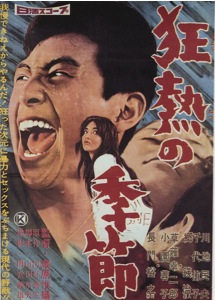

Image via Wikipedia
Koreyoshi Kurahara was one of the hourse directors for the Japanese studio Nikkatsu — perhaps most known in the US from the Criterion and Home Vision releases of Seijun Suzuki and Shohei Imamura‘s films. Nikkatsu was primarily a genre house; where other studios tended to have prestige directors as well as the normal entertainment releases, Nikkatsu didn’t really have any star directors (at least, the directors weren’t stars at Nikkatsu — many of them became known after the fact, including Koreyoshi Kurahara, who’d go on to direct Antartica, the highest grossing domestic film in Japan until Princess Mononoke). This particular film is a “juvenile deliquent” drama, focusing on a trio of kids just after they’d been released from jail and continue wreaking havoc on everyone.
The film was one of the few Nikkatsu action films released in the US, under the title The Weird Lovemakers, distributed by Audobon Films (and picked up for the VHS market by Something Weird); the official title, The Warped Ones, is a better title that better describes the contents, though “The Weird Lovemakers” definitely better describes the tone. It’s a very strange film. Words like “gonzo” are typically overused, but in this case, it seems an apt term for the filmmaking style.
The basic plot of a film is about the (off-screen) rape of Fumiko, a woman who happens be the fiancee of Kashiwagi, the man that got the teens arrested in the first part of the film; Kashiwagi treats her as if nothing happened, which distresses her as she feels soiled and broken. She attempts to make Akira atone for his crime, or apologize, or even acknowledge her, but he refuses — but doesn’t stop harassing her.
Eventually, she comes on the plan to have Yuki, the girl of the trio, rape Kashiwagi to put both halves of the couple back on equally soiled footing. Everything is fine for a little while, until it’s revealed that both Fumiko and Yuki are pregnant with the children from the two rapes.
In between, there’s lots of jazz — perhaps the only thing Akira is passionate about; that and his hatred of “phony jazz”. The score in the film is really well done, and you can see why Akira loves the music so much. There’re also a lot of little side-steps that have nothing to do with the plot, including, perhaps my favorite, when a frustrated Akira goes off swimming with a black American man for, well, not really much reason at all. It might not make sense, but it is AWESOME.
The last scene — which I won’t spoil — is GREAT. Both the content of it and the way it’s shot with a series of stills. In a way, it reminded me of the “explanation” scene of The American Astronaut. Great action photography taken from odd angles, putting the viewer at a sense of unease lend the last scene an extra punch.
This is one of the films as part of the touring program “No Borders, No Limits“, which I recommend you go to if it comes to your town. It’s been put together by Marc Walkow at Outcast Cinema, which has tour dates and booking information. Very highly recommended — though, if for some reason you can’t make it, rumor has it that this film might be seeing DVD soon.
